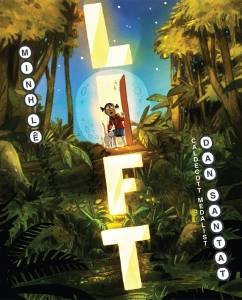A Q&A with Minh Lê and Dan Santat

LB School: What was it like working together on a second book?
Minh Lê: It was so much fun. My approach when working with an artist of Dan’s caliber is to provide just enough story to start the book… and then get out of the way. It’s total magic to toss a manuscript Dan’s way and then see what amazing things he comes up with.
Dan Santat: When I got the script for Lift, it immediately felt like the type of story that I wish I had written. Sometimes there are some ideas that seem so obviously brilliant that you sort of ask yourself why you hadn’t thought of it first. To me, that’s the sign of a really good idea. Minh has a very good way about his writing where he writes for the artist. He knows when to say things in the manuscript and he knows when the story is better told with illustrations and he’s very economical with his words so that when paired with images they work perfectly in synchronicity. After having completed two books together I think it’s safe for me to say that I’ve found my book making soul mate if there were such a thing.

LB School: Minh, where did the inspiration for Lift come from?
Minh Lê: I remember stepping into an elevator with my youngest son when he was an infant and wondering, “What in the world must he be thinking right now?” For a baby, it really is magic: You walk into this strange box, push a button, and next thing you know, the door opens to somewhere completely different. So of course, my next thought was: what if it actually did take you somewhere completely different.
Plus, I have never met a young child who didn’t like to push elevator buttons… so as far as kid-appeal goes, a magic elevator button seemed like a pretty decent place to start a story.
LB School: Dan, what was different in your approach to illustrating Lift?
Dan Santat: The text for Lift was very sparse. The majority of it was mostly visual directions and he and the publisher graciously allowed for me to flex my muscle of pushing visual narrative. There was no direction as to where Iris travelled to once she opened the door, there were no notes on what went on when she appeared in these new landscapes. Minh left all of it open to me to interpret. In my mind, a lot of the great moments in this book come in the form of building up moments of anticipation and after reading and sketching out several spreads to work out the pacing I realized I would need more than 40 pages to illustrate the story. My main goal was to add more and more panels to a page to force the reader to slow town their pace while simultaneously build up the anticipation of what was on the other side of the door. I wanted big wide open areas that contrast to the cramped quarters of the elevator, the constant presence of her brother, and her life in an apartment. To me, this story had the feel of a classic magical narrative that would have been written by by Chris Van Allsberg or David Wiesner back in the 80s and so I really tapped into the spirit of that work to get the right feel for the story.
